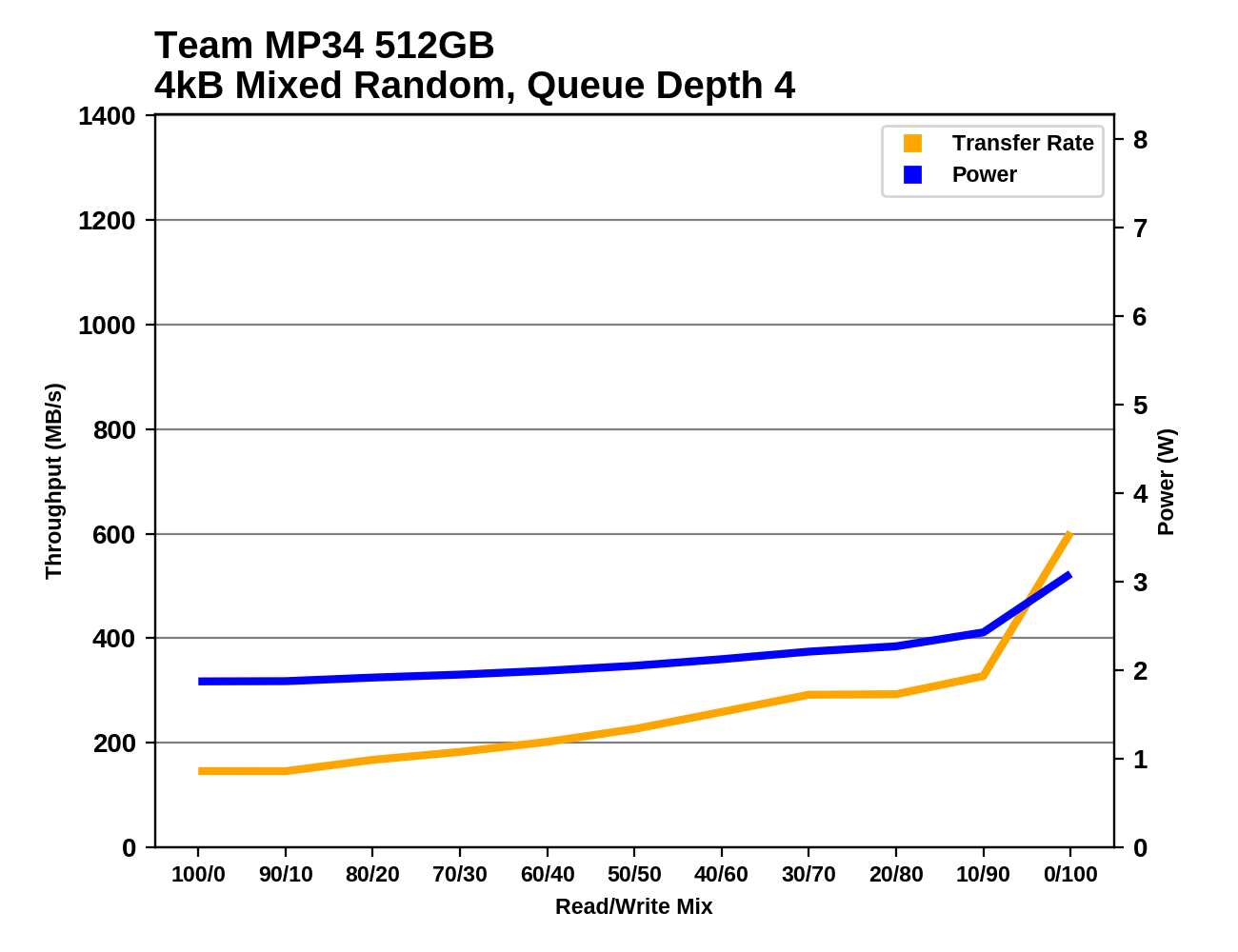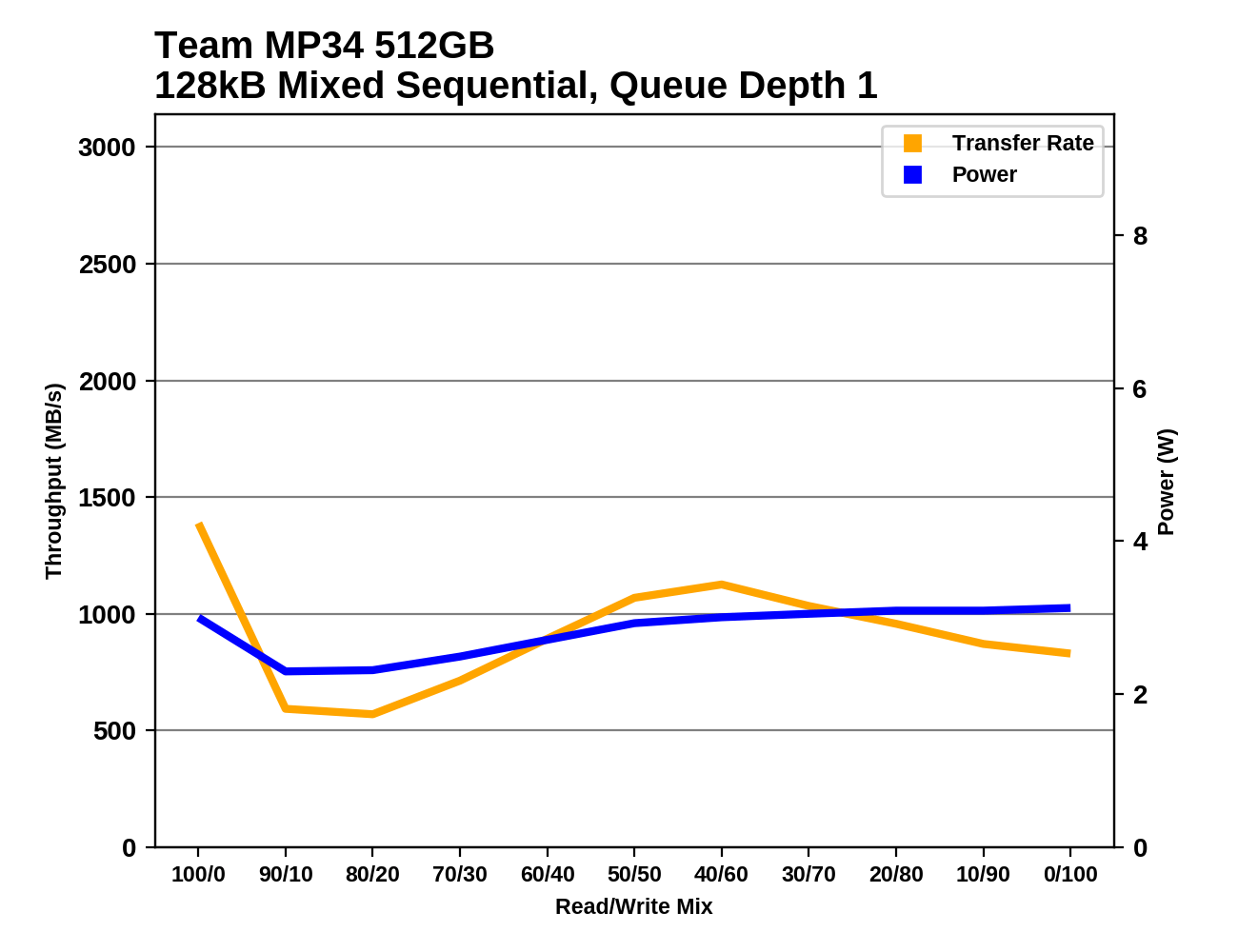The Team Group MP34 512GB SSD Review: Refining Phison's NVMe Workhorse
by Billy Tallis on May 15, 2019 9:00 AM EST- Posted in
- SSDs
- Storage
- Toshiba
- Phison
- M.2
- NVMe
- BiCS
- 3D TLC
- Team Group
- PS5012-E12
Mixed Random Performance
Our test of mixed random reads and writes covers mixes varying from pure reads to pure writes at 10% increments. Each mix is tested for up to 1 minute or 32GB of data transferred. The test is conducted with a queue depth of 4, and is limited to a 64GB span of the drive. In between each mix, the drive is given idle time of up to one minute so that the overall duty cycle is 50%.

The newer firmware on the Team Group MP34 gives it a slight edge over the Gigabyte Aorus RGB SSD, but both drives are significantly slower overall on the mixed random IO test than the fastest 512GB-class drives we have tested. The Samsung and Silicon Motion based competitors are even outperforming the higher-capacity Phison E12 drives.
 |
|||||||||
| Power Efficiency in MB/s/W | Average Power in W | ||||||||
The Team MP34's power efficiency during the mixed random IO test is a bit lower than the 1TB Phison E12 drives, but it's clearly more efficient that all the other 512GB-class drives in this bunch. The Gigabyte Aorus SSD's lower efficiency is no surprise given the RGB LEDs, but it actually still draws less power than the Samsung and ADATA drives.
 |
|||||||||
The Team MP34 has generally the same performance profile as the earlier Phison E12 drives, but it performs a bit better than the earlier firmware during the more write-heavy half of the test. The only large difference in performance is at the very end of the test, where the pure random write speed of the MP34 is a clear improvement over the Gigabyte Aorus. The competitors that offer much better overall performance have small advantages during the read-heavy portions of the test and build up a larger lead over the MP34 in the write-heavy half.
Mixed Sequential Performance
Our test of mixed sequential reads and writes differs from the mixed random I/O test by performing 128kB sequential accesses rather than 4kB accesses at random locations, and the sequential test is conducted at queue depth 1. The range of mixes tested is the same, and the timing and limits on data transfers are also the same as above.

Drive capacity is obviously the primary factor affecting overall performance on the mixed sequential IO test, with all of the 1TB class drives outperforming all of the 512GB class drives. The 500GB Samsung 970 EVO comes very close to matching the performance of some 1TB drives, and the ADATA SX8200 is not too far behind, but the Team MP34 doesn't get close and is only slightly faster than the drive with older Phison E12 firmware.
 |
|||||||||
| Power Efficiency in MB/s/W | Average Power in W | ||||||||
The Team MP34 provides competitive power efficiency for its capacity class when running the mixed sequential IO test. The 500GB Samsung 970 EVO is a bit more efficient, drawing much more power but also offering much more performance. The Toshiba RC100 entry-level NVMe drive provides the best efficiency in this capacity class, because it uses less power on average than even the Crucial MX500 SATA drive.
 |
|||||||||
The performance of the Team MP34 wobbles around as the workload shifts from mostly reads to mostly writes, but this is the same basic pattern we saw with the Gigabyte Aorus SSD, though the MP34's newer firmware brings slight improvements to the more write-heavy phases of the test. Overall, the MP34's performance is sub-par for the most read-heavy tests, but it holds up reasonably well against the competition during the more write-heavy parts of the test.










17 Comments
View All Comments
Samus - Wednesday, May 15, 2019 - link
Why is the WD Black missing from all the benchmarks - even the recently reviewed SN750 is missing?I’m at a loss here, you specifically mentioned it on the first page of the article, along with Samsung, yet included all the Samsung drives...
futrtrubl - Wednesday, May 15, 2019 - link
Last page. "..if we had the chance to test the 500GB WD Black SN750"kobblestown - Wednesday, May 15, 2019 - link
FWIW, I just bought a 480GB Corsair MP510 and the firmware is reported as ECFM12.2. I don't know if it's available for update of older devices though.ssd-user - Wednesday, May 15, 2019 - link
Can you _please_ sort the SSD's by worst-case ("disk full") numbers rather than best-case ones? I generally really like your reviews, but your sorting is simply wrong, and some horribly bad ssd's end up looking much better than they are because of it.Particularly for things like the 99% latency numbers it is inane to sort by the best case, since the whole point is about near-worst-case latencies, and bad controller should simply not be given the benefit of the doubt.
Note that unless you actually trim the ssd, even an empty filesystem will act like a full one, since the ssd doesn't know which parts are used. So as far as the ssd is concerned, it's all full. So the argument that "most people have lots of room on their disk" is quite likely bogus to begin with, but possibly entirely irrelevant even if it were to be true.
Death666Angel - Thursday, May 16, 2019 - link
They are storted by worst-case, just in reverse. And if you use an SSD without an automatic trim OS, it's kinda on you, isn't it?ssd-user - Thursday, May 16, 2019 - link
Death666Angel: please learn to read. They are *not* "sorted by worst-case, just in reverse".Look at the "ATSB - Heavy (99th Percentile Latency)" graph, just as an example.
In particular, look at the ADATA XPG SX8200 Pro 1TB one. Look at how absolutely *HORRIBLE* the latency is for that.
Yet the idiotic and incorrect sorting shows it as the second-best SSD on that list, because the *best-case* latency when the drive is empty is reasonable. But once it gets full, and $
Anybody who thinks that that drive should be second-best on that list is incompetent.
ssd-user - Thursday, May 16, 2019 - link
Fat-fingered the response. The "and $" should be "and garbage collection happens, latency becomes horrid".Death666Angel - Saturday, May 18, 2019 - link
I still stand by "If you have an OS that uses GC as a valid algorithm, you desever all the crap you brought upon yourself." But have fun being a blast at parties! Learn to read fricking diagrams and stop bitching. Or start being the change you wanna see in the world!leexgx - Saturday, May 18, 2019 - link
the issue is only with the dramless drives when they are above 60-70% full witch you should avoid (the sandisk/WD blue recant controller is cida dramless but it has 10mb of ram on the controller it self witch seems to be enough to mitigate the lack of a full blown dram)ssd-user - Sunday, May 19, 2019 - link
Exactly. The point is that you should avoid those drives.Which is why they shouldn't show up at the top of the charts. They are not top drives, they are the dregs, and they should show up as such.